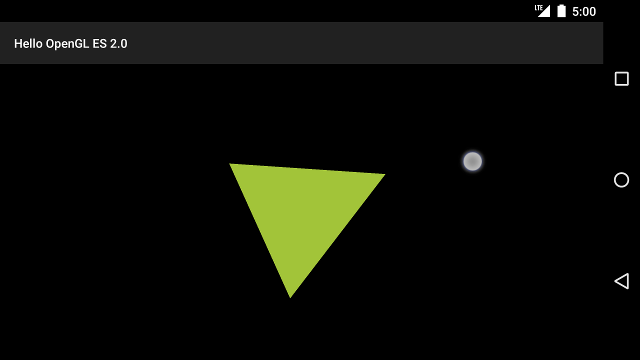让对象按照预设程序移动(例如旋转三角形)有助于吸引注意力,但如果您希望用户与您的 OpenGL ES 图形进行交互该怎么办?使 OpenGL ES 应用实现触摸交互的关键在于扩展您的 GLSurfaceView 实现,以替换 onTouchEvent() 方法来监听触摸事件。
本课程将向您展示如何监听触摸事件,从而让用户旋转 OpenGL ES 对象。
设置触摸监听器
为了让您的 OpenGL ES 应用响应触摸事件,您必须在您的 GLSurfaceView 类中实现 onTouchEvent() 方法。下面的示例实现展示了如何监听 MotionEvent.ACTION_MOVE 事件并将其转换为形状的旋转角度。
Kotlin
private const val TOUCH_SCALE_FACTOR: Float = 180.0f / 320f ... private var previousX: Float = 0f private var previousY: Float = 0f override fun onTouchEvent(e: MotionEvent): Boolean { // MotionEvent reports input details from the touch screen // and other input controls. In this case, you are only // interested in events where the touch position changed. val x: Float = e.x val y: Float = e.y when (e.action) { MotionEvent.ACTION_MOVE -> { var dx: Float = x - previousX var dy: Float = y - previousY // reverse direction of rotation above the mid-line if (y > height / 2) { dx *= -1 } // reverse direction of rotation to left of the mid-line if (x < width / 2) { dy *= -1 } renderer.angle += (dx + dy) * TOUCH_SCALE_FACTOR requestRender() } } previousX = x previousY = y return true }
Java
private final float TOUCH_SCALE_FACTOR = 180.0f / 320; private float previousX; private float previousY; @Override public boolean onTouchEvent(MotionEvent e) { // MotionEvent reports input details from the touch screen // and other input controls. In this case, you are only // interested in events where the touch position changed. float x = e.getX(); float y = e.getY(); switch (e.getAction()) { case MotionEvent.ACTION_MOVE: float dx = x - previousX; float dy = y - previousY; // reverse direction of rotation above the mid-line if (y > getHeight() / 2) { dx = dx * -1 ; } // reverse direction of rotation to left of the mid-line if (x < getWidth() / 2) { dy = dy * -1 ; } renderer.setAngle( renderer.getAngle() + ((dx + dy) * TOUCH_SCALE_FACTOR)); requestRender(); } previousX = x; previousY = y; return true; }
请注意,在计算旋转角度后,此方法会调用 requestRender() 来通知渲染器是时候渲染帧了。在此示例中,这种方法效率最高,因为除非旋转发生变化,否则无需重新绘制帧。但是,除非您还使用 setRenderMode() 方法要求渲染器仅在数据更改时重新绘制,否则这种方法对效率没有任何影响,因此请确保在渲染器中取消注释此行。
Kotlin
class MyGlSurfaceView(context: Context) : GLSurfaceView(context) { init { // Render the view only when there is a change in the drawing data renderMode = GLSurfaceView.RENDERMODE_WHEN_DIRTY } }
Java
public MyGLSurfaceView(Context context) { ... // Render the view only when there is a change in the drawing data setRenderMode(GLSurfaceView.RENDERMODE_WHEN_DIRTY); }
暴露旋转角度
上面的示例代码要求您通过在渲染器中添加公共成员来暴露旋转角度。由于渲染器代码在与应用主用户界面线程不同的独立线程上运行,您必须将此公共变量声明为 volatile。以下是声明变量并暴露 getter 和 setter 对的代码:
Kotlin
class MyGLRenderer4 : GLSurfaceView.Renderer { @Volatile var angle: Float = 0f }
Java
public class MyGLRenderer implements GLSurfaceView.Renderer { ... public volatile float mAngle; public float getAngle() { return mAngle; } public void setAngle(float angle) { mAngle = angle; } }
应用旋转
要应用由触摸输入生成的旋转,请注释掉生成角度的代码,并添加一个包含触摸输入生成的角度的变量。
Kotlin
override fun onDrawFrame(gl: GL10) { ... val scratch = FloatArray(16) // Create a rotation for the triangle // long time = SystemClock.uptimeMillis() % 4000L; // float angle = 0.090f * ((int) time); Matrix.setRotateM(rotationMatrix, 0, angle, 0f, 0f, -1.0f) // Combine the rotation matrix with the projection and camera view // Note that the mvpMatrix factor *must be first* in order // for the matrix multiplication product to be correct. Matrix.multiplyMM(scratch, 0, mvpMatrix, 0, rotationMatrix, 0) // Draw triangle triangle.draw(scratch) }
Java
public void onDrawFrame(GL10 gl) { ... float[] scratch = new float[16]; // Create a rotation for the triangle // long time = SystemClock.uptimeMillis() % 4000L; // float angle = 0.090f * ((int) time); Matrix.setRotateM(rotationMatrix, 0, mAngle, 0, 0, -1.0f); // Combine the rotation matrix with the projection and camera view // Note that the vPMatrix factor *must be first* in order // for the matrix multiplication product to be correct. Matrix.multiplyMM(scratch, 0, vPMatrix, 0, rotationMatrix, 0); // Draw triangle mTriangle.draw(scratch); }
完成上述步骤后,运行程序并在屏幕上拖动手指以旋转三角形。

图 1. 使用触摸输入旋转的三角形(圆圈显示触摸位置)。
